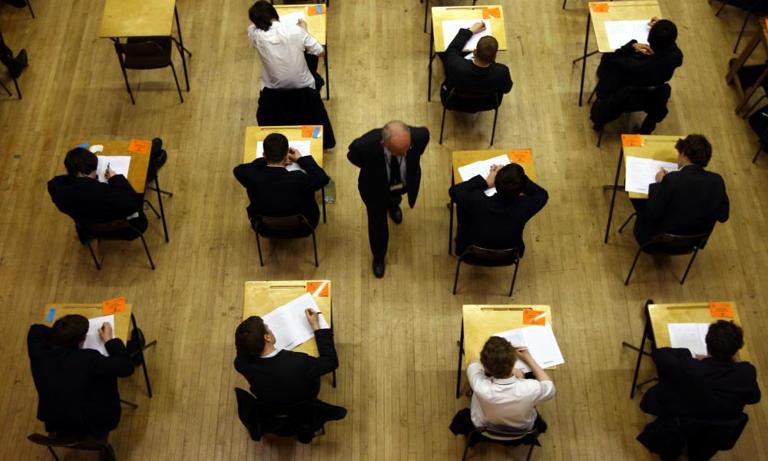




Parent Site: http://paragon.myvnc.com Paragon Publications UK

Is The Teaching Profession so Black & White?
Newspaper Articles
| Politics within Education |

Economic Migrants [-2]
CHAPTER
The British People Demand Accountability and Action to Rectify this Problem Today!

© Provided by The Guardian Photograph: David Jones/PA
There could be 230,000 fewer top grades in the UK compared with 2021, but 230,000 more than 2019, according to Prof Alan Smithers, director of the centre for education and employment research at the University of Buckingham.
Prof Smithers said the change in this year’s GCSE results was likely to be similar to what was seen in A-level results last week, when grades fell from pandemic highs but remained above 2019 levels.
Prof Smithers said the change in this year’s GCSE results was likely to be similar to what was seen in A-level results last week, when grades fell from pandemic highs but remained above 2019 levels.
Last year, the proportion of GCSE entries awarded top grades surged to an all-time high after exams were cancelled for the second year in a row due to Covid-19, and students were instead given results determined by their teachers.
Overall, 28.9% of UK GCSE entries were awarded one of the top grades, up by 2.7 percentage points on 2020. In 2019, when exams were last held, only a fifth (20.8%) of entries achieved at least a 7 or an A grade.
Prof Smithers said grades were expected to move back to around halfway between those of 2021 and 2019, meaning disappointment for many.
“In 2022, we can reasonably expect to see a drop in top grades, with many more failing to reach the pass level (C/4),” he said. “In England, the biggest percentage fall will be at Grade 9 and many more will fall below Grade 4.
Overall, 28.9% of UK GCSE entries were awarded one of the top grades, up by 2.7 percentage points on 2020. In 2019, when exams were last held, only a fifth (20.8%) of entries achieved at least a 7 or an A grade.
Prof Smithers said grades were expected to move back to around halfway between those of 2021 and 2019, meaning disappointment for many.
“In 2022, we can reasonably expect to see a drop in top grades, with many more failing to reach the pass level (C/4),” he said. “In England, the biggest percentage fall will be at Grade 9 and many more will fall below Grade 4.
“We can take the A-level results as pointers. At A-level, the top grades were cut, but not as far as the government was wanting, I suspect because high marks were scored in the easier exams, and lower grades for higher marks is going to be difficult to defend on appeal.”
He said he expected girls to remain “a long way ahead of boys, with only a small narrowing of the gap from the return to exams”. In the latest A-level results, girls continued to outperform boys overall, although the gap was smaller.
The proportion of girls who got an A or above was 2.2 percentage points higher than boys this year, compared with a 4.8 percentage points difference last year.
He said he expected girls to remain “a long way ahead of boys, with only a small narrowing of the gap from the return to exams”. In the latest A-level results, girls continued to outperform boys overall, although the gap was smaller.
The proportion of girls who got an A or above was 2.2 percentage points higher than boys this year, compared with a 4.8 percentage points difference last year.
This year’s A-level results also showed a growing attainment gap between the more affluent London and south-east regions and the north-east. While the gap between the south and the north-east was between 4 and 5 percentage points in 2019, it now stands at more than 8 percentage points.
As with A-levels, extra help was provided for GCSE students with the return to exams, including more generous grading, advance information on topics, formulae and equation sheets for GCSE maths, physics and combined science exams.
Prof Smithers said: “Girls have been a lot further ahead at GCSE than at A-level, so I would not expect to see a significant impact on GCSEs, especially with the modified exams.”
Figures covering GCSE entries from students in England, Wales and Northern Ireland will be published by the Joint Council for Qualifications (JCQ) on Thursday.
While traditional A*-G grades are used in Northern Ireland and Wales, in England these have been replaced with a 9-1 system, where 9 is the highest. A 4 is broadly equivalent to a C grade, and a 7 is broadly equivalent to an A.
A study, published last week, found that 16-year-olds who are eligible for free school meals are about 27 percentage points less likely to earn good GCSEs than their less disadvantaged peers, and concluded that the attainment gap between poorer pupils and their better-off classmates is as large now as it was 20 years ago.
As with A-levels, extra help was provided for GCSE students with the return to exams, including more generous grading, advance information on topics, formulae and equation sheets for GCSE maths, physics and combined science exams.
Prof Smithers said: “Girls have been a lot further ahead at GCSE than at A-level, so I would not expect to see a significant impact on GCSEs, especially with the modified exams.”
Figures covering GCSE entries from students in England, Wales and Northern Ireland will be published by the Joint Council for Qualifications (JCQ) on Thursday.
While traditional A*-G grades are used in Northern Ireland and Wales, in England these have been replaced with a 9-1 system, where 9 is the highest. A 4 is broadly equivalent to a C grade, and a 7 is broadly equivalent to an A.
A study, published last week, found that 16-year-olds who are eligible for free school meals are about 27 percentage points less likely to earn good GCSEs than their less disadvantaged peers, and concluded that the attainment gap between poorer pupils and their better-off classmates is as large now as it was 20 years ago.
Fail grades predicted to rise as GCSEs return to pre-pandemic levels
Courtesy: Guardian -Jessica Murray 22.008.22















